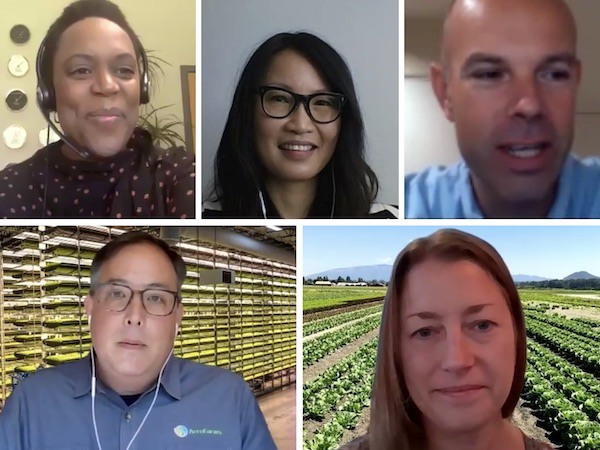This week’s PMA virtual town hall focused on five important macrotrends in society and how these trends affect the produce industry. “It is always a good time to think about the big picture, but especially now, when what happens in the future is so critical to guiding our everyday operations,” Lauren M. Scott of PMA says. She was joined by Marc Oshima, Co-Founder and CMO of AeroFarms, Sharon Foo, who works as a consultant, Elizabeth Nardi, CEO of Organically Grown Company, and Wyard Stomp, VP of Sales and Marketing to discuss this topic.

Globalization
The first of the macrotrends that was discussed was that of globalization. “In the context of covid-19, the interdependency of our supply chain has become increasingly clear,” says Oshima. “This interdependency is due to globalization. We have to think more specifically now in terms of food security and resiliency in the supply chain due to the pandemic,” he adds.
While globalization has been an important factor that has been increasingly impacting the entire world for decades now, and even arguably for centuries, the outbreak of the pandemic has also brought forth an increased popularity of locally grown produce. Nardi explains: “This is definitely something we have been seeing here on the West Coast, this trend of hyper-localization. The pandemic has given consumers a real desire to know where their food came from. Consumers are looking for trusted sources and want to support local economies.”
Population diversification
The diversification of populations is the next macrotrend that was discussed. This topic can be approached in many different ways. Nardi, for example, looked at the different lifestyle trends among the population: “We’re seeing that non-gmo has become one of the most recognized labels in the world, and organic has been seeing a significant growth in popularity. There is a shift in how people think about the products they are purchasing.”
For Oshima, the population diversification translates increasingly into product diversification. “With regard to food trends, borders have become seamless. Food continues to play a powerful role in bringing people together, so we think about it as a way of preserving customs and traditions of specific cultures through food.”
For Stomp, generational diversification is also an important aspect of this trend. “Millennials and Gen Z are a whole new game, and we are working to understand them better, especially Gen Z, who are now coming into play as consumers.”
Precision technology
The advancement of technology has always been closely integrated with the produce industry. This is something that AeroFarms, for example, was built on: “For us, it’s about optimizing the key attributes that consumers are looking for. We are working with chefs and the menu development now starts at the farm. We’re able to use technologies to build smart farms, which allow us to bypass season and deliver product consistently year-round,” Oshima shares.
“It’s not science for science’s sake, but for a greater reason,” Foo adds. “Today’s technology helps to solve the problems of the consumers. It’s important that people have a clear grasp on the drivers behind certain developments so that we can understand that the technology is there to enable great access for consumers to the healthy foods the industry has to offer.”
Climate adaptation
Changes in the climate and the environment are central to the agricultural industry, and so this next macrotrend is vitally important for everyone in the supply chain. “We like to look at agriculture as a way of reversing climate change” says Nardi. “There is so much we can do to pull the carbon out of the air and put it back into the soil.”
Foo explains that she looks at it in terms of regeneration rather than sustainability. “Realistically, there’s not much left to sustain, so we need to change our vocabulary and start looking at it as regeneration instead. We need to build a circular economy and build solutions.
Accelerated urbanization
The final macrotrend that was discussed was urbanization. The majority of the world’s population lives in urban areas, and the consumer trends in urban areas differ widely from those in rural areas. “Our produce is grown by the community, for the community. We have farms located in inner-city schools and growing inside cities. It is about diversifying the supply chain and improving last-mile efficiency, and indoor farming is a big part of that,” Oshima says.
Stomp sees urbanization as a creator of additional opportunities. “This macrotrend is one of the most important ones, from the sales and marketing point of view. Urbanization rates create a lot of opportunities, but they also require that we adjust how we approach the market. For example, people in urban areas shop more often, sometimes even going to the store multiple times a day. This creates a lot of opportunity, but in order to capitalize on these opportunities we need to recognize the trend and translate the data into a strategy. In the produce industry, so much of the business is focused on the short term – day to day and week to week, but it’s very important to keep track of these macrotrends, analyze the data and simplify to see how it impacts your business, what opportunities you can take from it, and then drive actionable strategies from there,” Stomp concludes.
Next week’s virtual town hall will focus on global trade issues and will include insights from leaders in trade about how to navigate difficult environments and address trade disruptions.
